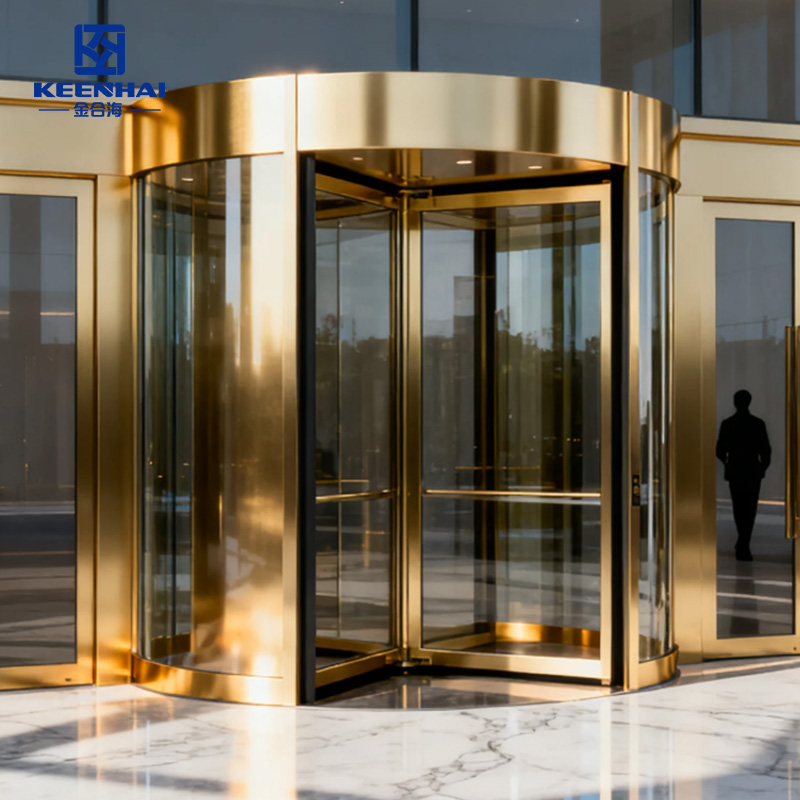In 2025, stainless steel sheet prices range from $2.3–$3.8 per kg, depending on grade, finish, and supplier region. 304 sheets remain the most popular for construction and kitchen applications, while PVD-coated options cost slightly more due to color processing. Always compare factory vs distributor prices before ordering in bulk to get the best long-term value.
1. Understanding Stainless Steel Glass Revolving Doors
De Modern Stainless Steel Glass Revolving Door is one of the most refined architectural entrance systems used in high-end hotels, airports, and commercial complexes. It combines the strength of stainless steel with the transparency of tempered glass, creating an entrance that’s both functional and visually stunning. These revolving doors are designed to control pedestrian flow, maintain interior climate, and offer an impressive first impression to visitors.
In luxury settings such as five-star hotels or corporate headquarters, revolving doors made from stainless steel and glass not only highlight modern aesthetics but also contribute to energy efficiency by reducing air infiltration. The combination of sleek metal frames and large glass panels allows natural light to flood interior lobbies while maintaining durability against constant daily use.
The stainless steel used—typically grade 304 or 316—is known for its corrosion resistance and polished finish. The glass panels, on the other hand, are often laminated or tempered for safety and acoustic insulation. The integration of these materials results in a reliable and elegant door system that suits both interior and exterior applications.
Below is a simplified comparison highlighting the practical advantages of stainless steel and glass over other revolving door materials:
| Material Comparison for Revolving Doors | Varaktighet | Visual Appeal | Maintenance Needs | Common Application |
|---|---|---|---|---|
| Stainless Steel + Glass | ★★★★★ | ★★★★★ | Låg | Luxury hotels, malls, airports |
| Aluminum + Glass | ★★★★☆ | ★★★★☆ | Låg | Office buildings, small malls |
| Bronze + Glass | ★★★★☆ | ★★★★★ | Medium | Historical or boutique entrances |
Every revolving entry door in stainless steel finish is engineered for high-traffic environments where both durability and presentation matter. Many architects now prefer customized configurations, such as 3-wing or 4-wing mechanisms, paired with motion sensors or climate-sealing strips to optimize energy performance.
In modern architectural design, Hotel Stainless Steel Revolving Doors are especially popular for their seamless integration with glass façades and polished PVD-coated surfaces that resist fingerprints and tarnish. These features make them ideal for busy entrances where aesthetics and hygiene must coexist.
A well-designed stainless steel glass door system acts not only as an entry point but also as a statement of brand sophistication. In high-end retail or shopping mall entrances, such installations enhance visibility from the street while maintaining a comfortable interior climate.
The rise of Guldfärgad PVD-karuselldörr i rostfritt stål models demonstrates how luxury finishes are shaping modern architecture. Gold-toned coatings on stainless steel structures bring a warm, elegant contrast to glass panels — often seen in boutique hotels or flagship stores.
Each of these designs represents a balance between engineering precision and artistic craftsmanship, reflecting how far entrance systems have evolved beyond simple doorways.

2. Design Options and Customization Choices
2.1 Frame Finishes and Glass Panel Styles
Stainless steel frames determine both durability and look. Most commercial projects choose 316-grade stainless for coastal or high-corrosion environments and 304-grade for typical urban installations. Finish choices change maintenance and appearance: polished mirror, satin/brushed, PVD-coated (gold or bronze), and powder-coated matte are standard options. PVD coatings deliver superior scratch resistance and long-term color stability compared with standard plating, which is why many premium entrances use PVD on high-touch areas.
Glass selection affects safety, acoustics, and light transmission. Typical glass specs used in revolving doors include:
-
Tempered safety glass — minimum thickness 10–12 mm (3/8″–1/2″) for single panels in mid-size doors.
-
Laminated glass — two layers with an interlayer (usually 0.38–1.52 mm) for higher security and post-breakage integrity.
-
Insulated/IGU panels — used when thermal performance matters, usually assembled in factory conditions for consistent seals.
Practical rule of thumb: choose tempered laminated glass for lobbies facing busy streets to combine impact resistance and sound reduction. In retail flagship stores, architects often prioritize low-iron glass to maximize clarity and color fidelity.
2.2 Door Size, Configuration, and Speed Control
Door configuration and geometry directly affect throughput, safety, and ADA compliance. Common configurations are 3-wing (3-pocket) och 4-wing (4-pocket) systems; designers sometimes specify 2-wing for narrower openings or aesthetic reasons. Typical clear opening widths and recommended passenger throughput:
| Configuration | Typical Clear Opening (each wing) | Recommended Use | Typical Rotation Speed |
|---|---|---|---|
| 3-wing | 800–1,000 mm (31–39 in) per compartment | High-traffic hotel lobbies | 1.0–1.5 rpm (recommended) |
| 4-wing | 650–850 mm (25–33 in) per compartment | Airports, large malls | 1.2–1.8 rpm (recommended) |
| 2-wing | 900–1,200 mm (35–47 in) per compartment | Narrow facades or boutique stores | 0.8–1.2 rpm (manual/slow automatic) |
Important sizing notes:
-
Measure the clear approach depth — revolving doors need at least 2.0–2.5 m (6.6–8.2 ft) of approach on either side for safe operation in busy sites.
-
For ADA concerns, provide an adjacent swing door or a dedicated wide-compartment option that allows wheelchair access without compromising the revolving unit’s airflow control.
Speed control choices split into manual clutch/drag systems och motorized variable-speed drives. Motorized systems give precise control:
-
Set entry speed to a low baseline (usually ~1.0 rpm) for steady pedestrian flow.
-
Use presence sensors to increase speed briefly if a crowd surge occurs.
-
Implement soft-start/soft-stop to reduce mechanical stress and improve passenger comfort.
2.3 Branding and Architectural Integration
Revolving doors function as brand statements when designers treat them as façade elements. You can integrate logos, custom metalwork, and backlit panels into canopies and door collars. Practical steps to integrate branding without hurting performance:
-
Select materials that match façade cladding (for example, choose the same PVD finish used on neighboring metal panels).
-
Specify low-reflectance glass or anti-glare coatings when digital signage sits behind or above the door to prevent visual conflict.
-
Coordinate structural loading with the building engineer early so decorative canopies or heavy signage don’t create unexpected torsion on the door head assembly.
Three quick implementation tips:
-
Coordinate electrical and sensor pathways during early design to avoid later chase conflicts.
-
Mock up a 1:1 sample of the branded collar (metal finish + logo) to verify color and fingerprint behavior.
-
Plan maintenance access — design removable panels that preserve the visual line while allowing technicians to reach motors and bearings.
A well-integrated revolving door increases perceived building value and reduces year-round HVAC losses—that’s why architects who want a lasting branded entrance invest in matched finishes and precise sensor tuning.

3. Performance and Functional Advantages
3.1 Energy Efficiency and Noise Reduction
A stainless steel glass revolving door maintains indoor climate far better than a swing or sliding system. Because only one compartment opens at a time, air exchange between indoor and outdoor zones is minimized—reducing HVAC energy loss by up to 30–40% in high-traffic buildings. Many modern revolving doors integrate double-glazed or laminated glass panels, which help maintain thermal balance while blocking external noise. In office lobbies or hotel entrances near main roads, laminated acoustic glass with Rw ratings above 35 dB effectively lowers ambient sound without changing transparency. Designers usually pair automatic speed control sensors with these insulation systems to stabilize indoor comfort and limit sudden air pressure shifts caused by revolving movement.
3.2 Durability and Corrosion Resistance
The core advantage of stainless steel is its long-term resistance to wear and oxidation. Grade 304 stainless performs well indoors, but for coastal cities or humid climates, 316-grade stainless steel with added molybdenum ensures superior resistance to salt corrosion and chemical exposure. To extend lifespan further, the surface can be PVD-coated, forming a dense, scratch-resistant layer that retains its sheen even after years of exposure. Mechanical components such as central shafts, bearings, and guide rollers are commonly made from heat-treated steel alloys, reducing friction loss and improving operational stability. Under regular maintenance, a high-quality stainless steel revolving door can operate smoothly for over 10 years with minimal visible degradation.
3.3 Weatherproof and Anti-Fingerprint Features
Weatherproofing is achieved through multi-layer sealing strips, floor brushes, and roof gaskets that prevent water infiltration and air leakage during heavy rain or wind gusts. High-precision manufacturing keeps the air permeability below 1.5 m³/h·m², ensuring consistent interior temperature control. For exterior applications, designers often specify UV-resistant silicone joints och drainage channels beneath the threshold to handle condensation. A growing number of modern finishes also include anti-fingerprint nanocoatings, which repel oils and reduce cleaning frequency by nearly 40% compared to uncoated metal. This coating not only preserves the door’s premium appearance but also enhances hygiene, making it especially suitable for public spaces such as hotels, airports, and corporate headquarters.
4. Cost Factors and Pricing Insights
4.1 Price Range by Door Type and Size
The cost of a Stainless Steel Glass Revolving Door varies significantly depending on size, materials, and automation features. Standard 3-wing doors for medium-traffic commercial lobbies typically range from $15,000 to $25,000, while high-capacity 4-wing or custom PVD-coated models can exceed $40,000. Hotel applications often require additional finishing touches and safety features, making Hotel Stainless Steel Revolving Doors slightly higher in cost.
Below is a comparison illustrating typical costs for different door types and configurations:
| Door Type | Size (Approx.) | Material/Finish | Uppskattat pris (USD) | Common Use |
|---|---|---|---|---|
| 3-Wing Standard | 2500–3000 mm | Stainless Steel + Clear Glass | 15,000–25,000 | Office or hotel lobby |
| 4-Wing High Capacity | 3000–3500 mm | Stainless Steel + Laminated Glass | 30,000–45,000 | Airports, shopping malls |
| Gold PVD Finish | 2800–3200 mm | PVD Stainless Steel + Laminated Glass | 35,000–50,000 | Luxury hotels, flagship stores |
4.2 Cost of Installation and Maintenance
Installation of a high-quality revolving door requires precise structural alignment and electrical integration. Typical installation costs add 15–25% of the product price, depending on site conditions and labor rates. Steps usually include:
-
Site survey and foundation prep — ensure floor load capacity and clear approach.
-
Positioning the door frame — use laser leveling for vertical alignment.
-
Installing the central shaft and wing assemblies — verify smooth rotation before anchoring.
-
Electrical and sensor setup — configure motorized speed and safety sensors.
-
Sealing and finishing — apply gaskets, floor brushes, and weatherproofing.
Maintenance is typically minimal for stainless steel doors but still requires biannual lubrication of bearings, cleaning of glass and metal surfaces, and inspection of seals and sensors. For busy environments like Shopping Mall Stainless Steel Revolving Doors, automated monitoring systems can alert facility managers when minor adjustments or component replacements are needed, reducing downtime and extending lifespan.
4.3 Budgeting Tips for Commercial Projects
When budgeting for commercial installations, it’s important to factor in total lifecycle costs, not just the initial purchase. High-quality materials like 316 stainless steel or PVD coatings increase upfront cost but reduce long-term maintenance. Consider these steps:
-
Define capacity needs first — avoid overbuilding large 4-wing doors for low-traffic locations.
-
Include installation variables — electrical, structural, and finishing work can add significant expense.
-
Evaluate automation level — motorized doors increase upfront cost but enhance safety and energy efficiency.
-
Plan for periodic maintenance — allocate budget for lubrication, sensor calibration, and glass cleaning to preserve performance.
Smart budgeting ensures that your stainless steel glass door system delivers both a premium aesthetic and reliable long-term operation, without unexpected cost spikes during the first five years.

5. Installation and Maintenance Guide
5.1 Step-by-Step Installation Overview
Installing a Stainless Steel Glass Revolving Door requires precision and coordination between structural and electrical components. Proper installation ensures smooth operation, safety, and long-term durability. Typical installation steps include:
-
Site Preparation – Confirm floor level, load capacity, and clear approach space. Measure doorway dimensions and mark anchor points for the frame.
-
Frame Placement – Position the main stainless steel frame and secure it with anchors or bolts. Ensure vertical alignment using a laser level.
-
Central Shaft Assembly – Install the central rotating shaft, verifying that it spins freely without lateral movement. Bearings and shaft supports must be tightened to manufacturer specifications.
-
Wing Panel Installation – Attach glass panels to stainless steel wings, ensuring proper spacing for smooth rotation. Use protective pads to prevent scratches during installation.
-
Motor and Sensor Integration – Connect the drive motor, control panel, and motion sensors for automatic doors. Test rotational speed and sensor response to ensure compliance with safety standards.
-
Sealing and Finishing – Install floor brushes, roof gaskets, and weatherproof seals to prevent drafts and water ingress. Check that all surfaces are aligned and polished.
For high-traffic sites, such as Hotel Stainless Steel Revolving Doors, it is recommended to perform multiple rotation tests to ensure consistent speed and passenger comfort.
5.2 Routine Cleaning and Lubrication Practices
Regular maintenance keeps a stainless steel glass door functional and visually appealing. Cleaning and lubrication should be scheduled at least every 6 months, or more frequently in busy entrances. Recommended practices:
-
Glaspaneler: Use a mild, non-abrasive cleaner and microfiber cloth. Avoid harsh chemicals that can damage laminated or tempered glass.
-
Metal Surfaces: Wipe stainless steel frames with a pH-neutral cleaner. For PVD finishes, use a soft cloth to prevent scratches.
-
Bearings and Moving Parts: Apply recommended lubricants to central shafts and rollers. Check for loose fasteners and tighten as necessary.
-
Sensors and Motors: Inspect electrical connections and ensure motion sensors are free of dust and obstruction.
Proper maintenance extends door lifespan and maintains energy efficiency, while also minimizing unexpected repair costs.
5.3 Common Issues and Troubleshooting Tips
Even high-quality revolving doors can encounter minor issues over time. Common problems include uneven rotation, sensor misalignment, and unusual noise from bearings. Typical troubleshooting steps:
-
Check Alignment: Inspect the central shaft and wing assemblies for misalignment or debris obstructing rotation.
-
Sensor Calibration: Recalibrate motion sensors if the door stops prematurely or starts too slowly.
-
Lubricate Bearings: Apply appropriate lubricant to the central shaft and roller bearings if rotation feels stiff.
-
Inspect Seals and Brushes: Replace worn gaskets or floor brushes to maintain smooth operation and weatherproofing.
-
Electrical Diagnostics: For motorized doors, check voltage and wiring to ensure consistent speed control.
Routine inspection combined with timely intervention prevents small issues from escalating, ensuring a Stainless Steel Glass Revolving Door continues operating reliably in high-traffic commercial or hospitality environments.
Choosing the right Stainless Steel Glass Revolving Door can transform a building entrance into a statement of style, security, and efficiency. From hotels to shopping malls, modern designs combine durable stainless steel frames, tempered glass panels, and advanced automation for smooth operation and long-lasting performance. For a comprehensive range of options and professional guidance, visit our official website at pvdstainlesssteel.com to explore models, finishes, and customization possibilities.






